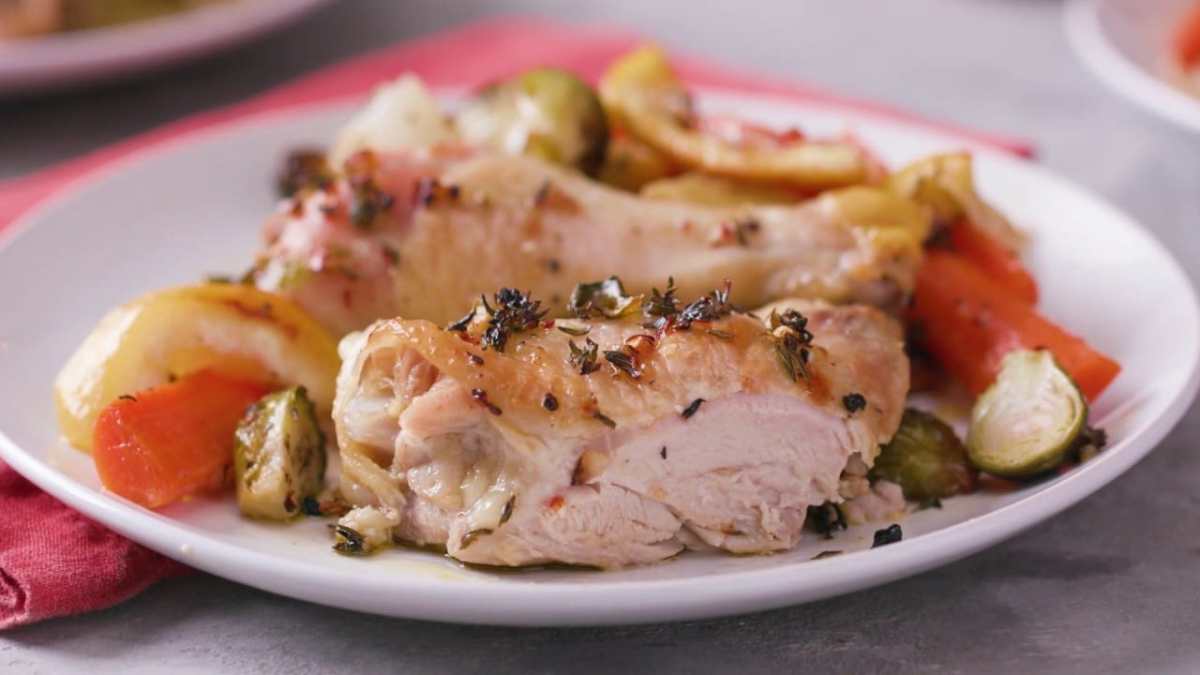Craving the vibrant flavors and health benefits of a Paleo diet but worried about the cost? Imagine savoring succulent chicken stir-fries bursting with seasonal vegetables, hearty protein bowls packed with nutritional goodness, and satisfying breakfasts that won’t break the bank. This isn’t a dream; it’s a delicious reality achievable with careful planning and resourceful cooking. Discover how to transform simple, affordable ingredients into mouthwatering Paleo meals that nourish your body and your budget.
This guide unveils the secrets to navigating the Paleo lifestyle without sacrificing your financial well-being. We’ll explore inexpensive protein sources, seasonal produce strategies, and smart meal planning techniques that stretch your grocery dollars further. Learn to maximize the use of ingredients, minimize waste, and create a diverse range of delicious Paleo recipes that are both satisfying and budget-friendly. Get ready to embark on a culinary adventure that’s kind to your wallet and your taste buds.
Affordable Paleo Vegetables and Fruits
Embracing a Paleo diet doesn’t have to break the bank. By focusing on seasonal produce and smart shopping strategies, you can enjoy a vibrant and nutritious diet without sacrificing your budget. This section will guide you through selecting affordable Paleo-friendly fruits and vegetables, preserving them effectively, and creating delicious, budget-conscious meals.
Seasonal Guide to Inexpensive Paleo Produce
Choosing fruits and vegetables that are in season is the key to affordability. Seasonal produce is abundant, leading to lower prices. Furthermore, in-season fruits and vegetables are typically at their peak flavor and nutritional value. The following guide highlights inexpensive options throughout the year, along with storage and preservation tips to minimize waste.
- Spring: Asparagus spears, vibrant green spinach leaves, bursting-with-flavor radishes, and sweet, juicy strawberries. Asparagus and spinach can be blanched and frozen for later use. Strawberries freeze well, too, perfect for smoothies.
- Summer: Sun-ripened tomatoes, plump zucchini, sweet corn on the cob, and juicy watermelons. Tomatoes can be canned or made into sauce. Zucchini can be frozen or used in various dishes. Watermelon can be juiced or preserved as candied watermelon.
- Autumn: Butternut squash, sweet potatoes, Brussels sprouts, and crisp apples. Butternut squash and sweet potatoes can be roasted and stored in the refrigerator for later use or pureed and frozen. Apples can be baked or made into applesauce and stored.
- Winter: Root vegetables like carrots and parsnips, hearty kale, and citrus fruits like oranges and grapefruit. Carrots and parsnips can be stored in a cool, dark place for several weeks. Kale can be wilted and frozen. Citrus fruits can be juiced and frozen or zested for later use.
Simple Paleo Side Dish Recipes
These recipes showcase the versatility of affordable seasonal produce.
Roasted Root Vegetables with Herbs
- Ingredients: 1 lb carrots, 1 lb parsnips, 2 tbsp olive oil, 1 tsp dried rosemary, 1 tsp dried thyme, salt and pepper to taste.
- Instructions: Preheat oven to 400°F (200°C). Chop carrots and parsnips into 1-inch pieces. Toss with olive oil, rosemary, thyme, salt, and pepper. Spread on a baking sheet and roast for 25-30 minutes, or until tender and slightly caramelized.
- Nutritional Information (per serving, assuming 4 servings): Approximately 150 calories, 7g fat, 20g carbohydrates, 4g protein.
Sautéed Spinach with Garlic
- Ingredients: 10 oz fresh spinach, 2 cloves garlic, 1 tbsp olive oil, salt and pepper to taste.
- Instructions: Mince garlic. Heat olive oil in a pan over medium heat. Add garlic and sauté for 30 seconds until fragrant. Add spinach and sauté for 2-3 minutes, or until wilted. Season with salt and pepper.
- Nutritional Information (per serving, assuming 2 servings): Approximately 70 calories, 5g fat, 5g carbohydrates, 5g protein.
Simple Steamed Broccoli with Lemon
- Ingredients: 1 head broccoli, 1 tbsp olive oil, juice of ½ lemon, salt and pepper to taste.
- Instructions: Cut broccoli into florets. Steam until tender-crisp, about 5-7 minutes. Toss with olive oil, lemon juice, salt, and pepper.
- Nutritional Information (per serving, assuming 2 servings): Approximately 50 calories, 3g fat, 7g carbohydrates, 3g protein.
Strategies for Buying Produce Economically
Buying produce in bulk or during sales can significantly reduce your grocery bill.
- Buy in bulk: When possible, purchase larger quantities of fruits and vegetables, especially those that store well, like root vegetables and apples. Consider splitting bulk purchases with friends or family to share the cost and reduce waste.
- Shop sales and utilize coupons: Check weekly grocery store flyers for sales on seasonal produce. Many stores also offer digital coupons that can be loaded onto loyalty cards for additional savings.
- Consider frozen produce: Frozen fruits and vegetables are often just as nutritious as fresh and are significantly cheaper, especially during the off-season.
- Grow your own: Even a small herb garden or a few tomato plants can significantly reduce your grocery bill and provide fresh, flavorful ingredients.
Cost-Effective Paleo Meal Planning

Planning paleo meals on a budget requires strategic thinking and a focus on affordable, nutrient-rich ingredients. This involves choosing seasonal produce, utilizing versatile proteins, and embracing creative meal prepping techniques to minimize waste and maximize flavor. By focusing on whole foods and planning ahead, delicious and healthy paleo meals can be enjoyed without breaking the bank.
A Sample Weekly Paleo Meal Plan
This sample weekly meal plan demonstrates how to create delicious and budget-friendly paleo meals for seven days. The estimated costs are approximate and may vary depending on location and sales. Remember to adjust portion sizes to fit your individual needs.
| Day | Meal | Recipe Name | Estimated Cost |
|---|---|---|---|
| Monday | Breakfast | Coconut Flour Pancakes with Berries | $1.50 |
| Monday | Lunch | Leftover Chicken and Vegetable Stir-fry | $2.00 |
| Monday | Dinner | Sheet Pan Chicken and Veggies | $4.00 |
| Tuesday | Breakfast | Scrambled Eggs with Spinach | $1.00 |
| Tuesday | Lunch | Leftover Sheet Pan Chicken and Veggies | $2.00 |
| Tuesday | Dinner | Ground Beef and Cabbage Stir-fry | $3.50 |
| Wednesday | Breakfast | Chia Seed Pudding with Almond Milk | $1.25 |
| Wednesday | Lunch | Leftover Ground Beef and Cabbage Stir-fry | $2.00 |
| Wednesday | Dinner | Salmon Patties with Roasted Asparagus | $5.00 |
| Thursday | Breakfast | Coconut Yogurt with Berries | $1.50 |
| Thursday | Lunch | Leftover Salmon Patties and Asparagus | $2.50 |
| Thursday | Dinner | Chicken and Vegetable Soup | $3.00 |
| Friday | Breakfast | Scrambled Eggs with Avocado | $1.75 |
| Friday | Lunch | Leftover Chicken and Vegetable Soup | $2.00 |
| Friday | Dinner | Pork Chops with Roasted Sweet Potatoes | $4.50 |
| Saturday | Breakfast | Bacon and Eggs | $2.00 |
| Saturday | Lunch | Leftover Pork Chops and Sweet Potatoes | $2.50 |
| Saturday | Dinner | Steak with Green Beans | $6.00 |
| Sunday | Breakfast | Pancakes with Berries | $1.50 |
| Sunday | Lunch | Leftover Steak and Green Beans | $3.00 |
| Sunday | Dinner | Chicken and Vegetable Stir-fry | $4.00 |
A Detailed Weekly Shopping List
Careful planning of your grocery shopping list is key to minimizing costs and waste. This list is based on the above meal plan and categorizes items for efficient grocery store navigation.
Produce: Berries (strawberries, blueberries), spinach, asparagus, cabbage, sweet potatoes, green beans, avocado.
Protein: Chicken breasts, ground beef, salmon fillets, pork chops, steak, eggs, bacon.
Pantry Staples: Coconut flour, chia seeds, coconut yogurt, almond milk.
Other: Olive oil, salt, pepper, various herbs and spices.
Creative Leftover Utilization
Strategic use of leftovers is a powerful tool in budget-friendly paleo cooking. For example, leftover roasted chicken can be shredded and added to salads, soups, or used to create chicken salad. Leftover cooked vegetables can be incorporated into omelets, frittatas, or stir-fries. This minimizes food waste and reduces the need to cook from scratch every meal, saving both time and money. Imagine the vibrant green of leftover asparagus becoming a flavorful addition to the next day’s scrambled eggs, adding a splash of color and nutrients to an otherwise simple dish. Similarly, the succulent texture of leftover chicken can transform a simple salad into a hearty and satisfying lunch.
Simple Paleo Pantry Staples
Building a budget-friendly paleo pantry doesn’t require exotic ingredients or frequent shopping trips. A few versatile staples can form the foundation of many delicious and nutritious meals, saving you both money and time. These core ingredients offer long shelf lives, minimizing food waste and maximizing your budget.
A well-stocked paleo pantry revolves around a few key items that provide the building blocks for countless meals. These are not only affordable but also incredibly versatile, allowing you to create a wide range of dishes with minimal effort and expense.
Essential Paleo Pantry Staples
The following five items form the bedrock of a cost-effective paleo diet, offering both nutritional value and culinary adaptability. Their long shelf life means less frequent shopping and reduced food waste, contributing significantly to your budget.
- Canned Sardines or Salmon: Packed with protein, healthy fats, and essential nutrients, these are incredibly affordable and convenient protein sources. Their long shelf life makes them a pantry staple. Imagine the rich, oily flesh of the sardines, their delicate bones easily consumed for extra calcium, a quick and healthy lunch option or a flavorful addition to salads.
- Canned Coconut Milk: A creamy, versatile ingredient ideal for soups, stews, curries, and even desserts. Full-fat coconut milk adds richness and healthy fats without breaking the bank. Picture the thick, luscious creaminess swirling into a vibrant Thai-inspired coconut curry, or forming the base of a decadent, yet surprisingly healthy, paleo pudding.
- Dried Unsweetened Coconut Flakes: A great source of fiber and healthy fats, these can be used in baking, as a topping for yogurt or smoothies, or even as a crunchy addition to savory dishes. Envision the delicate, snow-like flakes adding a subtle sweetness and satisfying crunch to your morning smoothie or sprinkled generously over a hearty chicken stew.
- Olive Oil: A cornerstone of the paleo diet, olive oil is a healthy fat source used for cooking, dressing salads, and adding flavor. Choose extra virgin olive oil for its superior taste and health benefits. Imagine the vibrant green-gold liquid shimmering in a pan, searing vegetables to perfection, or drizzled elegantly over a fresh salad, imparting its rich, fruity aroma.
- Dried Spices: A small investment in dried spices like cumin, paprika, garlic powder, onion powder, and chili powder can transform simple meals into flavorful feasts. These spices have an extensive shelf life and add depth to any dish. Picture the warm, earthy aroma of cumin blending with the smoky paprika, creating a vibrant tapestry of flavor in a hearty stew or a simple roasted chicken.
Simple Paleo Recipes Using Pantry Staples
These recipes demonstrate the versatility and cost-effectiveness of these five core ingredients.
Coconut Curry with Sardines
- Sauté finely chopped onion in olive oil until softened.
- Add a generous spoonful of curry powder and sauté for another minute.
- Pour in a can of full-fat coconut milk and bring to a simmer.
- Add a can of drained sardines, breaking them into smaller pieces.
- Simmer for 10 minutes, allowing the flavors to meld.
- Serve over cauliflower rice or with a side of steamed greens.
Savory Coconut Flake Crusted Sardines
- Preheat oven to 375°F (190°C).
- Drain a can of sardines.
- Coat the sardines generously with olive oil and dried spices (paprika, garlic powder, etc.).
- Press dried coconut flakes onto the oiled and spiced sardines.
- Bake for 10-12 minutes, until the flakes are golden brown and the sardines are heated through.
Quick Coconut Milk Soup
- Heat olive oil in a saucepan.
- Add finely chopped onion and garlic powder; sauté until softened.
- Pour in a can of full-fat coconut milk and bring to a simmer.
- Season with salt, pepper, and any other desired spices (cumin, chili powder, etc.).
- Simmer for 5-7 minutes.
Quick Weeknight Meals with Pantry Staples
These staples are ideal for creating quick and easy meals on busy weeknights. A simple salad with sardines and a drizzle of olive oil, a quick coconut milk soup with added vegetables (if available), or sardines on a bed of greens with a sprinkle of coconut flakes are all nutritious and satisfying options. The combination of canned goods and spices minimizes cooking time and maximizes flavor. Even a simple pan-fried sardine with a sprinkle of spices can be a satisfying and quick meal.
Embracing a Paleo lifestyle on a budget is entirely possible—a testament to the power of mindful planning and creative cooking. By strategically selecting affordable protein sources, utilizing seasonal produce, and mastering the art of meal prepping and minimizing waste, you can enjoy the vibrant flavors and health benefits of Paleo without the hefty price tag. This guide has equipped you with the knowledge and recipes to craft delicious, nutritious, and budget-conscious Paleo meals, ensuring a journey towards a healthier and happier you, without straining your finances. Remember, delicious and healthy eating doesn’t have to be expensive!
Essential Questionnaire
Can I still eat out occasionally on a budget-friendly Paleo diet?
Yes, but plan ahead! Pack snacks and meals to avoid impulse purchases. Look for restaurants with Paleo-friendly options and consider sharing dishes to reduce costs.
What if I don’t have much time for cooking?
Focus on simple, one-pot or sheet pan meals. Utilize your pantry staples for quick weeknight dinners. Prepare larger batches on the weekend to have leftovers for busy weekdays.
How can I avoid food waste on a budget?
Plan your meals carefully based on a shopping list. Store produce properly to extend its shelf life. Use leftovers creatively in new dishes, and freeze excess portions for future meals.
Are there any free resources to help with budget-friendly Paleo meal planning?
Yes! Explore online Paleo communities and blogs for free recipe ideas and meal planning templates. Many offer budget-friendly options and tips.


